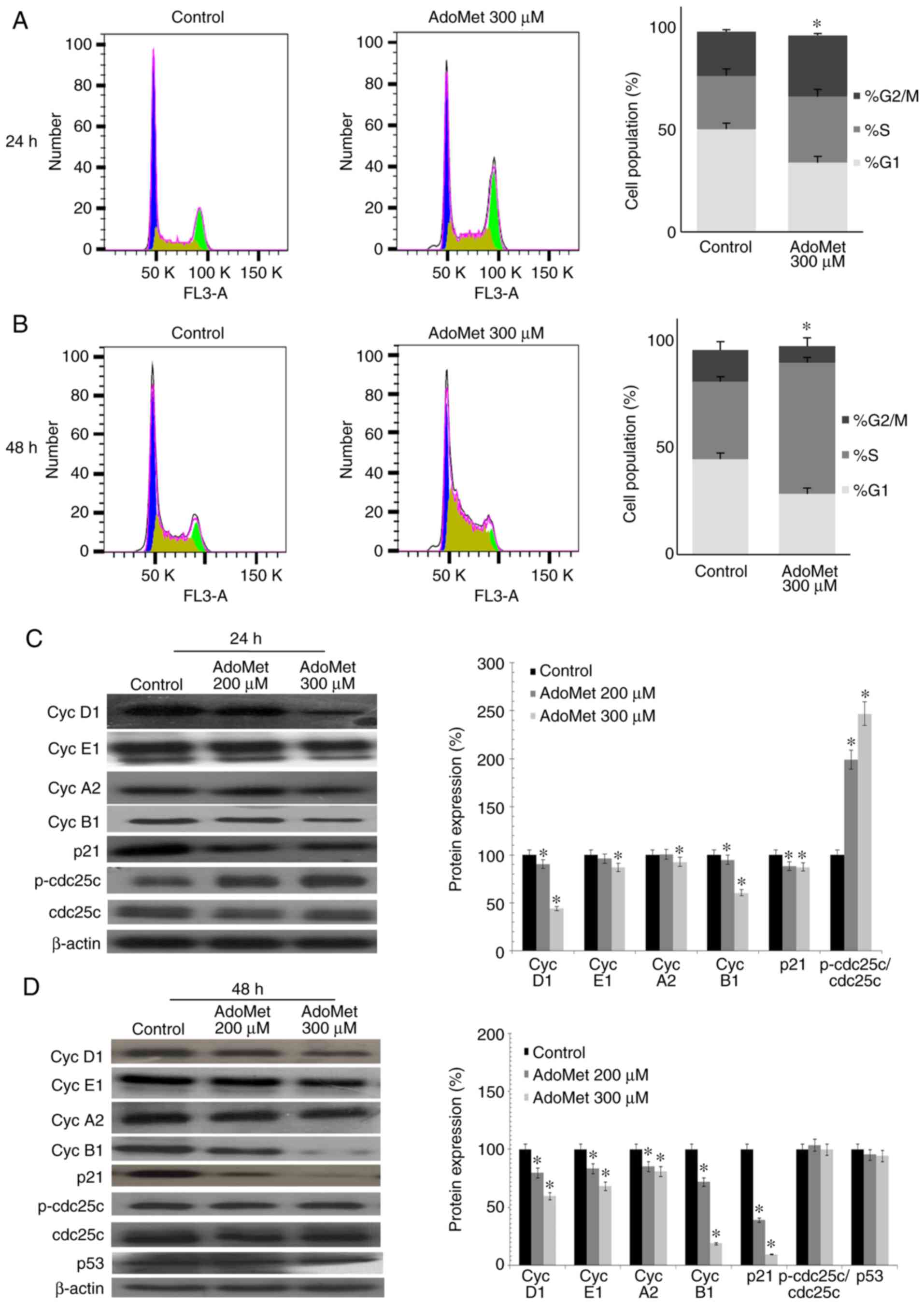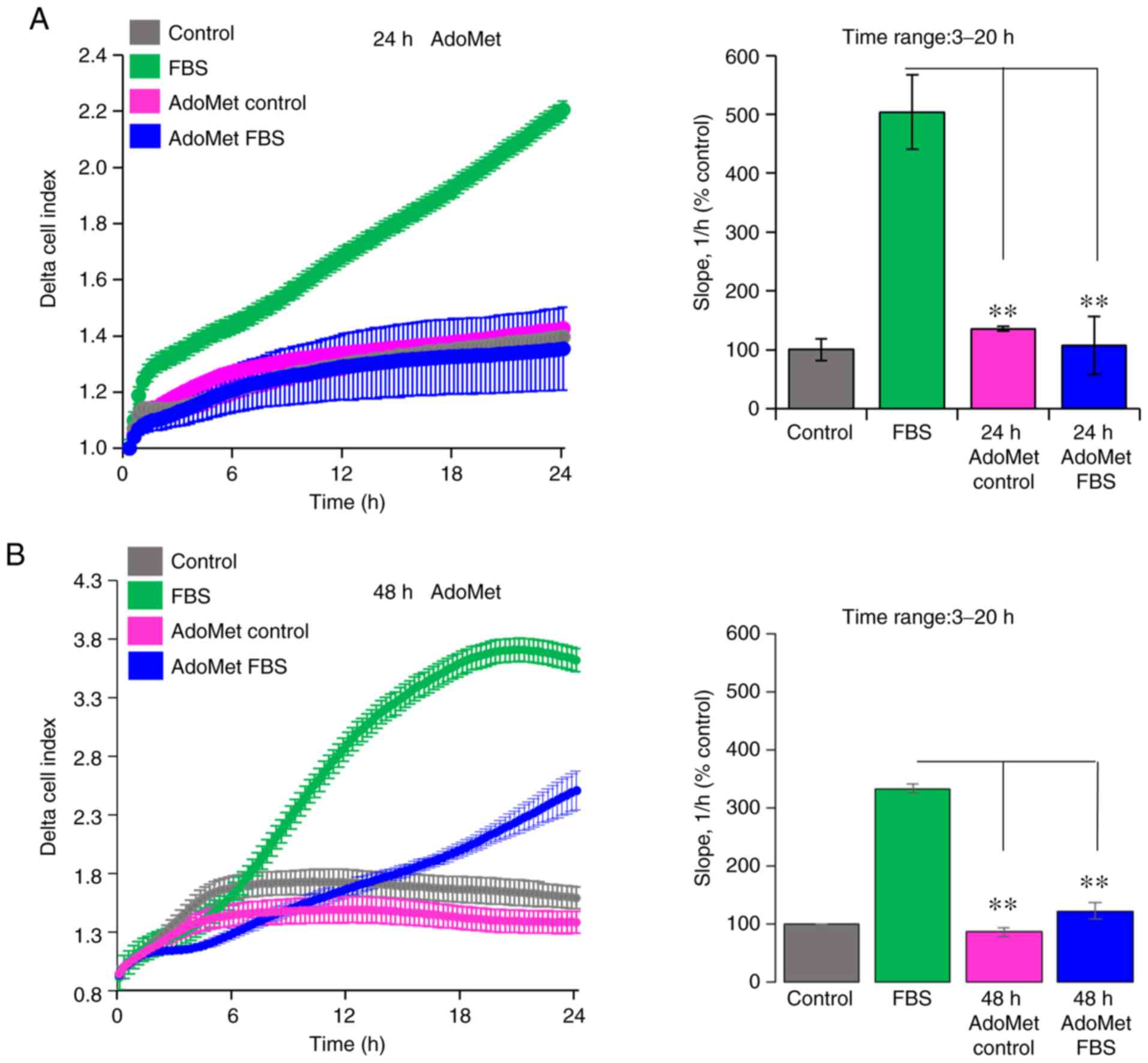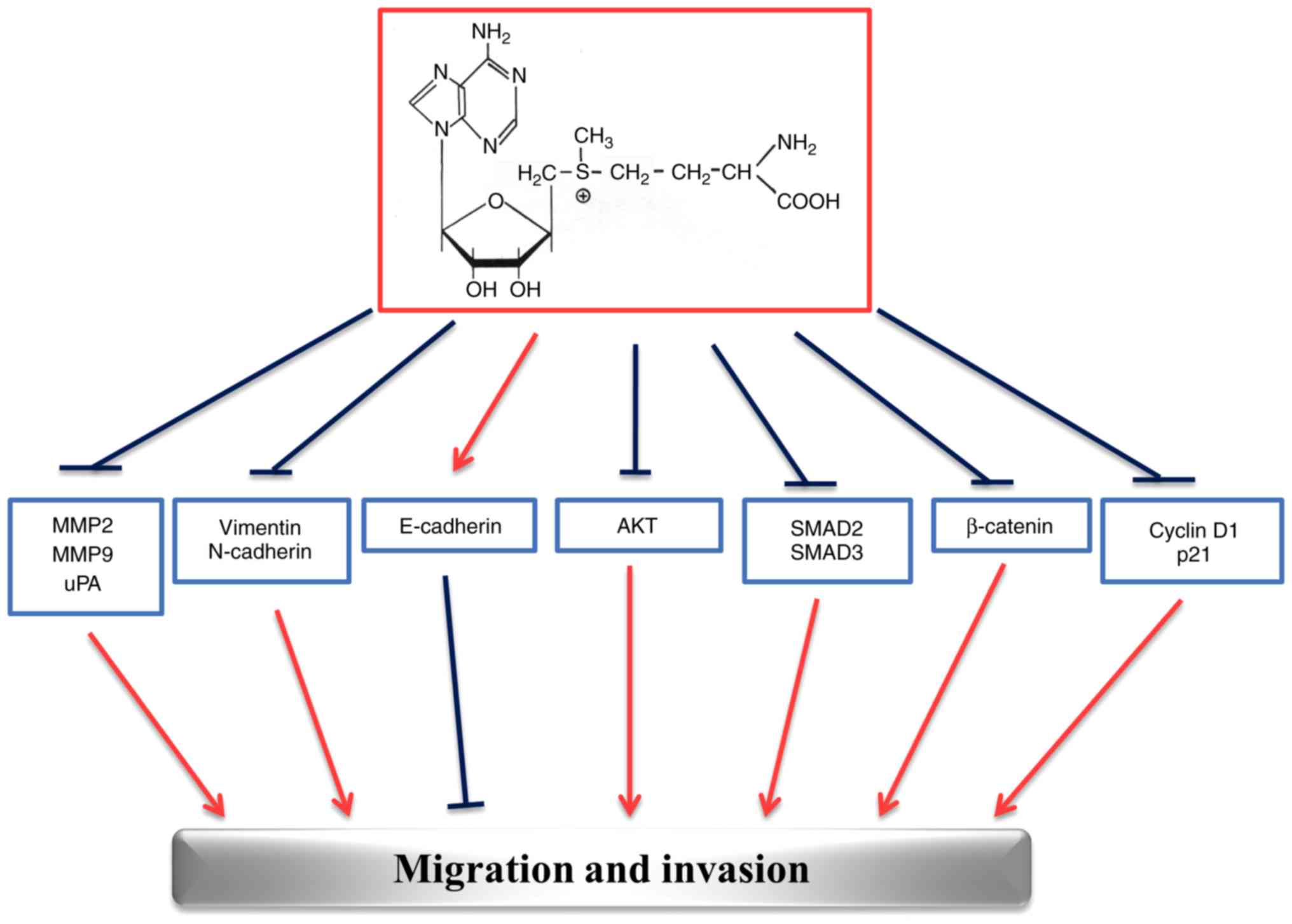|
1
|
Chin D, Boyle GM, Porceddu S, Theile DR,
Parsons PG and Coman WB: Head and neck cancer: Past, present and
future. Expert Rev Anticancer Ther. 6:1111–1118. 2006. View Article : Google Scholar : PubMed/NCBI
|
|
2
|
Marur S and Forastiere AA: Head and neck
squamous cell carcinoma: Update on epidemiology, diagnosis, and
treatment. Mayo Clin Proc. 91:386–396. 2016. View Article : Google Scholar : PubMed/NCBI
|
|
3
|
Kumar M, Nanavati R, Modi TG and Dobariya
C: Oral cancer: Etiology and risk factors: A review. J Cancer Res
Ther. 12:458–463. 2016. View Article : Google Scholar : PubMed/NCBI
|
|
4
|
Kulkarni P and Saxena U: Head and neck
cancers, the neglected malignancies: Present and future treatment
strategies. Expert Opin Ther Targets. 18:351–354. 2014. View Article : Google Scholar : PubMed/NCBI
|
|
5
|
Lu SC: S-Adenosylmethionine. Int J Biochem
Cell Biol. 32:391–395. 2000. View Article : Google Scholar : PubMed/NCBI
|
|
6
|
Mato MJ, Cor rales FJ, Lu SC and Avila MA:
S-Adenosylmethionine: A control switch that regulates liver
function. FASEB J. 16:15–26. 2002. View Article : Google Scholar : PubMed/NCBI
|
|
7
|
Fontecave M, Atta M and Mulliez E:
S-Adenosylmethionine: Nothing goes to waste. Trends Biochem Sci.
29:243–249. 2004. View Article : Google Scholar : PubMed/NCBI
|
|
8
|
Ansorena E, García-Trevijano ER,
Martínez-Chantar ML, Huang ZZ, Chen L, Mato JM, Iraburu M, Lu SC
and Avila MA: S-Adenosylmethionine and methylthioadenosine are
anti-apoptotic in cultured rat hepatocytes but pro-apoptotic in
human hepatoma cells. Hepatol. 35:274–280. 2002. View Article : Google Scholar
|
|
9
|
Lu SC and Mato JM: S-Adenosylmethionine in
cell growth, apoptosis and liver cancer. J Gastroenterol Hepatol.
23(Suppl 1): S73–S77. 2008. View Article : Google Scholar : PubMed/NCBI
|
|
10
|
Martínez-López N, Varela-Rey M, Ariz U,
Embade N, Vazquez-Chantada M, Fernandez-Ramos D, Gomez-Santos L, Lu
SC, Mato JM and Martinez-Chantar ML: S-Adenosylmethionine and
proliferation: New pathways, new targets. Biochem Soc Trans.
36:848–852. 2008. View Article : Google Scholar : PubMed/NCBI
|
|
11
|
Ilisso CP, Sapio L, Delle Cave D, Illiano
M, Spina A, Cacciapuoti G, Naviglio S and Porcelli M:
S-Adenosylmethionine affects ERK1/2 and Stat3 pathways and induces
apoptosis in osteosarcoma cells. J Cell Physiol. 231:428–435. 2016.
View Article : Google Scholar
|
|
12
|
Cave DD, Desiderio V, Mosca L, Ilisso CP,
Mele L, Caraglia M, Cacciapuoti G and Porcelli M:
S-Adenosylmethionine-mediated apoptosis is potentiated by autophagy
inhibition induced by chloroquine in human breast cancer cells. J
Cell Physiol. 233:1370–1383. 2018. View Article : Google Scholar
|
|
13
|
Mosca L, Pagano M, Ilisso CP, Cave DD,
Desiderio V, Mele L, Caraglia M, Cacciapuoti G and Porcelli M:
AdoMet triggers apoptosis in head and neck squamous cancer by
inducing ER stress and potentiates cell sensitivity to cisplatin. J
Cell Physiol. 234:13277–13291. 2019. View Article : Google Scholar
|
|
14
|
Steeg PS: Tumour metastasis: Mechanistic
insights and clinical challenges. Nat Med. 12:895–904. 2006.
View Article : Google Scholar : PubMed/NCBI
|
|
15
|
Braakhuis BJ, Senft A, de Bree R, de Vries
J, Ylstra B, Cloos J, Kuik DJ, Leemans CR and Brakenhoff RH:
Expression profiling and prediction of distant metastases in head
and neck squamous cell carcinoma. J Clin Pathol. 59:1254–1260.
2006. View Article : Google Scholar : PubMed/NCBI
|
|
16
|
Pakneshan P, Szyf M, Farias-Eisner R and
Rabbani SA: Reversal of the hypomethylation status of urokinase
(uPA) promoter blocks breast cancer growth and metastasis. J Biol
Chem. 279:31735–31744. 2004. View Article : Google Scholar : PubMed/NCBI
|
|
17
|
Shukeir N, Pakneshan P, Chen G, Szyf M and
Rabbani SA: Alteration of the methylation status of tumor-promoting
genes decreases prostate cancer cell invasiveness and tumorigenesis
in vitro and in vivo. Cancer Res. 66:9202–9210. 2006. View Article : Google Scholar : PubMed/NCBI
|
|
18
|
Chik F, Machnes Z and Szyf M: Synergistic
anti-breast cancer effect of a combined treatment with the methyl
donor S-adenosylmethionine and the DNA methylation inhibitor
5-aza-2'-deoxycytidine. Carcinogenesis. 35:138–144. 2014.
View Article : Google Scholar
|
|
19
|
Hussain Z, Khan MI, Shahid M and Almajhdi
FN: S-adenosylmethionine, a methyl donor, up regulates tissue
inhibitor of metalloproteinase-2 in colorectal cancer. Genet Mol
Res. 12:1106–1118. 2013. View Article : Google Scholar : PubMed/NCBI
|
|
20
|
Parashar S, Cheishvili D, Arakelian A,
Hussain Z, Tanvir I, Khan HA, Szyf M and Rabbani SA:
S-Adenosylmethionine blocks osteosarcoma cells proliferation and
invasion in vitro and tumor metastasis in vivo: Therapeutic and
diagnostic clinical applications. Cancer Med. 4:732–744. 2015.
View Article : Google Scholar : PubMed/NCBI
|
|
21
|
Liu Y, Bi T, Liu L, Gao Q, Shen G and Qin
L: S-Adenosylmethionine synergistically enhances the antitumor
effect of gemcitabine against pancreatic cancer through JAK2/STAT3
pathway. Naunyn Schmiedebergs Arch Pharmacol. 392:615–622. 2019.
View Article : Google Scholar : PubMed/NCBI
|
|
22
|
Sun L, Zhang J, Yang Q, Si Y, Liu Y, Wang
Q, Han F and Huang Z: Synergistic Effects of SAM and selenium
compounds on proliferation, migration and adhesion of HeLa cells.
Anticancer Res. 37:4433–4441. 2017.PubMed/NCBI
|
|
23
|
Vermes I, Haanen C, Steffens-Nakken H and
Reutelingsperger C: A novel assay for apoptosis. Flow cytometric
detection of phosphatidylserine expression on early apoptotic cells
using fluorescein labelled Annexin V. J Immunol Methods. 184:39–51.
1995. View Article : Google Scholar : PubMed/NCBI
|
|
24
|
Bradford MM: Rapid and sensitive method
for the quantitation of microgram quantities of protein utilizing
the principle of protein-dye binding. Anal Biochem. 72:248–254.
1976. View Article : Google Scholar : PubMed/NCBI
|
|
25
|
Fratangelo F, Camerlingo R, Carriero MV,
Pirozzi G, Palmieri G, Gentilcore G, Ragone C, Minopoli M, Ascierto
PA and Motti ML: Effect of ABT-888 on the apoptosis, motility and
invasiveness of BRAFi-resistant melanoma cells. Int J Oncol.
53:1149–1159. 2018.PubMed/NCBI
|
|
26
|
Ingangi V, Bifulco K, Yousif AM, Ragone C,
Motti ML, Rea D, Minopoli M, Botti G, Scognamiglio G, Fazioli F, et
al: The urokinase receptor-derived cyclic peptide [SRSRY]
suppresses neovascularization and intravasation of osteosarcoma and
chon-drosarcoma cells. Oncotarget. 7:54474–54487. 2016. View Article : Google Scholar : PubMed/NCBI
|
|
27
|
Malumbres M and Barbacid M: Mammalian
cyclin-dependent kinases. Trends Biochem Sci. 30:630–641. 2005.
View Article : Google Scholar : PubMed/NCBI
|
|
28
|
Gutierrez GJ, Tsuji T, Cross JV, Davis RJ,
Templeton DJ, Jiang W and Ronai ZA: JNK-mediated phosphorylation of
Cdc25C regulates cell cycle entry and G(2)/M DNA damage checkpoint.
J Biol Chem. 285:14217–14228. 2010. View Article : Google Scholar : PubMed/NCBI
|
|
29
|
Kanwal R and Gupta S: Epigenetic
modifications in cancer. Clin Genet. 81:303–311. 2012. View Article : Google Scholar
|
|
30
|
Carriero MV and Stoppelli MP: The
urokinase-type plasminogen activator and the generation of
inhibitors of urokinase activity and signaling. Curr Pharm Des.
17:1944–1961. 2011. View Article : Google Scholar : PubMed/NCBI
|
|
31
|
Kessenbrock K, Plaks V and Werb Z: Matrix
metalloproteinases: Regulators of the tumor microenvironment. Cell.
141:52–67. 2010. View Article : Google Scholar : PubMed/NCBI
|
|
32
|
Kidacki M, Lehman HL, Warrick JI and
Stairs DB: Signaling pathways supporting tumor invasion in head and
neck squamous cell carcinoma. J Clin Exp Pathol. 5:2272014.
|
|
33
|
Silva BS, Yamamoto FP, Pontes FS, Cury SE,
Fonseca FP, Pontes HA and Pinto-Júnior DD: TWIST and p-Akt immune
expression in normal oral epithelium, oral dysplasia and in oral
squamous cell carcinoma. Med Oral Patol Oral Cir Bucal. 17:e29–e34.
2012. View Article : Google Scholar
|
|
34
|
Zuo JH, Zhu W, Li MY, Li XH, Yi H, Zeng
GQ, Wan XX, He QY, Li JH, Qu JQ, et al: Activation of EGFR promotes
squamous carcinoma SCC10A cell migration and invasion via inducing
EMT-like phenotype change and MMP-9-mediated degradation of
E-cadherin. J Cell Biochem. 112:2508–2517. 2011. View Article : Google Scholar : PubMed/NCBI
|
|
35
|
Sheng S, Qiao M and Pardee AB: Metastasis
and AKT activation. J Cell Physiol. 218:451–454. 2009. View Article : Google Scholar
|
|
36
|
Marcucci F, Stassi G and De Maria R:
Epithelial-mesenchymal transition: A new target in anticancer drug
discovery. Nat Rev Drug Discov. 15:311–325. 2016. View Article : Google Scholar : PubMed/NCBI
|
|
37
|
Xu W, Yang Z and Lu N: A new role for the
PI3K/Akt signaling pathway in the epithelial-mesenchymal
transition. Cell Adh Migr. 9:317–324. 2015. View Article : Google Scholar : PubMed/NCBI
|
|
38
|
Feng XH and Derynck R: Specificity and
versatility in TGF-β signaling through Smads. Annu Rev Cell Dev
Biol. 21:659–693. 2005. View Article : Google Scholar
|
|
39
|
Suriyamurthy S, Baker D, Ten Dijke P and
Iyengar PV: Epigenetic reprogramming of TGF-β signaling in breast
cancer. Cancers (Basel). 11. pp. E7262019, View Article : Google Scholar
|
|
40
|
Guo W, Flanagan J, Jasuja R, Kirkland J,
Jiang L and Bhasin S: The effects of myostatin on adipogenic
differentiation of human bone marrow-derived mesenchymal stem cells
are mediated through cross-communication between Smad3 and
Wnt/beta-catenin signaling pathway. J Biol Chem. 283:9136–9145.
2008. View Article : Google Scholar : PubMed/NCBI
|
|
41
|
Minoo P and Li C: Cross-talk between
transforming growth factor-beta and Wingless/Int pathways in lung
development and disease. Int J Biochem Cell Biol. 42:809–812. 2010.
View Article : Google Scholar : PubMed/NCBI
|
|
42
|
Liu J, Wang Y, Pan Q, Su Y, Zhang Z, Han
J, Zhu X, Tang C and Hu D: Wnt/β-catenin pathway forms a negative
feedback loop during TGF-β1 induced human normal skin
fibroblast-to-myofi-broblast transition. J Dermatol Sci. 65:38–49.
2012. View Article : Google Scholar
|
|
43
|
Boldbaatar A, Lee S, Han S, Jeong AL, Ka
HI, Buyanravjikh S, Lee JH, Lim JS, Lee MS and Yang Y: Eupatolide
inhibits the TGF-β1-induced migration of breast cancer cells via
downregu-lation of SMAD3 phosphorylation and transcriptional
repression of ALK5. Oncol Lett. 14:6031–6039. 2017.PubMed/NCBI
|
|
44
|
Jin Y, Chen W, Yang H, Yan Z, Lai Z, Feng
J, Peng J and Lin J: Scutellaria barbata D. Don inhibits migration
and invasion of colorectal cancer cells via suppression of PI3K/AKT
and TGF-β/Smad signaling pathways. Exp Ther Med. 14:5527–5534.
2017.PubMed/NCBI
|
|
45
|
Cai W, Yu D, Fan J, Liang X, Jin H, Liu C,
Zhu M, Shen T, Zhang R, Hu W, et al: Quercetin inhibits
transforming growth factor β1-induced epithelial-mesenchymal
transition in human retinal pigment epithelial cells via the Smad
pathway. Drug Des Devel Ther. 12:4149–4161. 2018. View Article : Google Scholar :
|
|
46
|
Fustè NP, Castelblanco E, Felip I,
Santacana M, Fernández-Hernández R, Gatius S, Pedraza N, Pallarés
J, Cemeli T, Valls J, et al: Characterization of cytoplasmic cyclin
D1 as a marker of invasiveness in cancer. Oncotarget.
7:26979–26991. 2016. View Article : Google Scholar : PubMed/NCBI
|
|
47
|
Georgakilas AG, Martin OA and Bonner WM:
p21: A two-faced genome guardian. Trends Mol Med. 23:310–319. 2017.
View Article : Google Scholar : PubMed/NCBI
|
|
48
|
Jung YS, Qian Y and Chen X: Examination of
the expanding pathways for the regulation of p21 expression and
activity. Cell Signal. 22:1003–1012. 2010. View Article : Google Scholar : PubMed/NCBI
|
|
49
|
Dai M, Al-Odaini AA, Arakelian A, Rabbani
SA, Ali S and Lebrun JJ: A novel function for p21Cip1 and
acetyltransferase p/CAF as critical transcriptional regulators of
TGFβ-mediated breast cancer cell migration and invasion. Breast
Cancer Res. 14:R1272012. View Article : Google Scholar
|
|
50
|
Dai M, Al-Odaini AA, Fils-Aimé N,
Villatoro MA, Guo J, Arakelian A, Rabbani SA, Ali S and Lebrun JJ:
Cyclin D1 cooperates with p21 to regulate TGFβ-mediated breast
cancer cell migration and tumor local invasion. Breast Cancer Res.
15:R492013. View Article : Google Scholar
|
|
51
|
Dasari S and Tchounwou PB: Cisplatin in
cancer therapy: Molecular mechanisms of action. Eur J Pharmacol.
740:364–378. 2014. View Article : Google Scholar : PubMed/NCBI
|
|
52
|
Yin P, Song G and Jiang Z: Cisplatin
suppresses proliferation, migration and invasion of nasopharyngeal
carcinoma cells in vitro by repressing the
Wnt/β-catenin/Endothelin-1 axis via activating B cell translocation
gene 1. Cancer Chemother Pharmacol. 81:863–872. 2018. View Article : Google Scholar : PubMed/NCBI
|
|
53
|
Luo J, Li YN, Wang F, Zhang WM and Geng X:
S-adenosylmethionine inhibits the growth of cancer cells by
reversing the hypomethylation status of c-myc and H-ras in human
gastric cancer and colon cancer. Int J Biol Sci. 6:784–795. 2010.
View Article : Google Scholar : PubMed/NCBI
|
|
54
|
Lu SC and Mato JM: S-adenosylmethionine in
liver health, injury, and cancer. Physiol Rev. 92:1515–1542. 2012.
View Article : Google Scholar : PubMed/NCBI
|
|
55
|
Mahmood N, Cheishvili D, Arakelian A,
Tanvir I, Khan HA, Pépin AS, Szyf M and Rabbani SA: Methyl donor
S-adenosylmethionine (SAM) supplementation attenuates breast cancer
growth, invasion, and metastasis in vivo; therapeutic and
chemopreventive applications. Oncotarget. 9:5169–5183. 2018.
View Article : Google Scholar : PubMed/NCBI
|





















